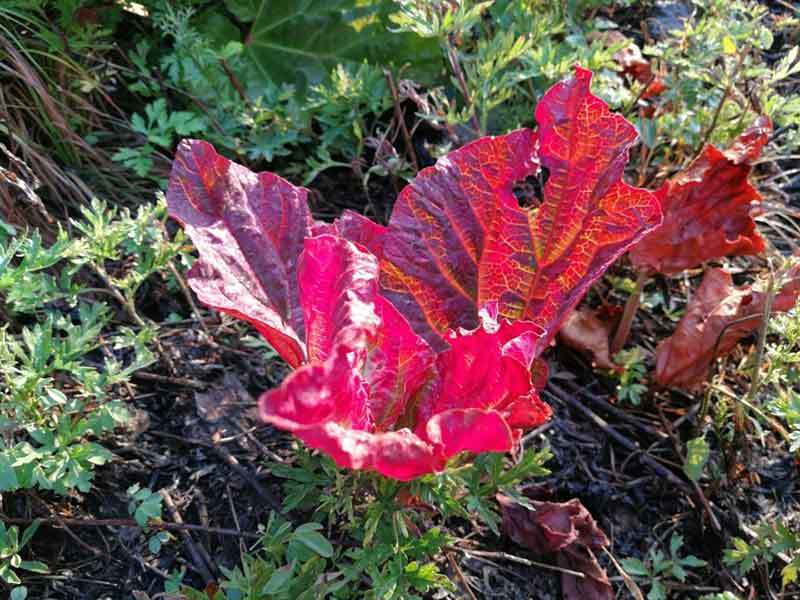Rhubarb Leaves Turning Red [Causes & Fixes]
Introduction
Rhubarb leaves turn red reveal vital clues about a plant’s health and life cycle. You should understand what causes rhubarb leaves to turn red. This can ensure a bountiful harvest.
Why Are My Rhubarb Leaves Turning Red?
Environmental Factors
Prolonged Sunlight Exposure: Rhubarb plants typically prefer partial shade. Excessive sunlight can cause stress and lead to rhubarb leaves turning red. If your rhubarb has large, reddened areas, these patches may be the result of too much direct sun.
Temperature Fluctuations: Sudden changes in temperature can also bring rhubarb leaves to turn red. Warm days followed by frosty nights can cause the plant to think it's fall. In preparation, it shifts its energy stores to the roots. The leaves begin to lose chlorophyll. This triggering the red color as a response to stress.
Soil Conditions: Red leaves may also be a sign of soil issues. High soil pH can lock up nutrients. They will be unavailable to the plants. Poor drainage or oversaturation can lead to a lack of oxygen to the roots. This stunts the plant's growth and causes the telltale redness.
Nutritional Deficiencies
Lack of Nutrients: Rhubarb is a heavy feeder. Specific micronutrient deficiencies can cause chlorophyll breakdown. For example, iron or magnesium. This can lead to rhubarb leaves turning yellow and red.
Imbalance of Nutrients: Having one nutrient in abundance while others are lacking can prevent the plant from taking up the right balance. Thereby leading to problems with nutrient translocation.
Pest Infestations and Diseases
Common Pests: Rhubarb is susceptible to different pests. For example, aphids, spider mites, and rhubarb curculio. They suck the sap and nutrients from their host. This can lead to the discoloration of leaves.
Fungal and Bacterial Infections: Fungal infections such as rhubarb leaf spot and bacterial diseases like rhubarb blight can elicit rhubarb leaves turning red. These diseases can spread rapidly in the right conditions. For example, excessive moisture.
Genetic Factors
Varieties Prone to Red Leaves: Some rhubarb cultivars have been bred explicitly for their red coloration. For example, Crimson Red and Raspberry Red. This genetic propensity to produce red leaves signifies varietal traits rather than problems with the plant's health.
Hybridization Effects: Crossbreeding and hybridization can introduce new plant varieties with unique characteristics. This genetic mixing can create robust plants with variegated leaf colors.

Solutions and Remedies
Adjusting Environmental Conditions
Proper Sunlight Exposure: Ensure your rhubarb is getting adequate sunlight. A minimum of 6 hours of full sun is preferable. If your plants are shaded, try moving them to a sunnier spot.
Temperature and Humidity Control: Rhubarb prefers cool temperatures. It can show signs of stress if it’s too warm. Monitor your garden and provide shading or mulching as necessary.
Soil Management Techniques: You should regular weeding and maintenance of soil conditions. This can greatly impact plant health. Compacted soil can inhibit root growth. This leads to nutrient uptake issues.
Nutritional Management
Soil Testing and Amendment: It’s essential to know the nutrient content of your soil. Most garden centers offer soil test kits for a modest price. You can also send a sample to a lab.
Fertilization Practices: If you identify a nutrient imbalance, amend the soil with the appropriate fertilizers. Organic options are gentle and effective over time. For example, compost, manure, or kelp.
Foliar Feeding Methods: Foliar feeding is a helpful supplement. The plants can quickly absorb these nutrients. However, this method should not replace a comprehensive soil management plan.
Pest and Disease Control
Integrated pest management is a great approach. It can balance biological, cultural and chemical control methods. Aphids, spider mites and cutworms are common pests. You can treat them with neem oil or insecticidal soap.
Common diseases can also lead to rhubarb leaves turning red. For example, rhizoctonia crown rot. This fungal infection thrives in damp and crowded conditions. To prevent its occurrence, ensure proper spacing of rhubarb plants and avoid over-watering. If identified, it might be necessary to remove it. Destroy infected plants to prevent spreading.
Cultivar Selection and Management
Choosing the right variety can make a substantial difference. Some cultivars are more resistant to typical issues. For example, Victoria rhubarb has hardiness and resistance to disease. Once established, proper care is vital. You should fertilize rhubarb in early spring with a balanced fertilizer.
Excessive nitrogen can cause plants more susceptible to disease. This may result in nutrient imbalances. You can use organic slow-release fertilizers to avoid this. Supplement with compost or well-rotted manure, especially in subsequent years.
Proper spacing is also critical. Rhubarb plants need about three to four feet of space to grow healthily. Crowding leads to stunted growth and red leaves. Dividing plants every five years.
Conclusion
Keep an eye on your rhubarb plants. Not all red leaves mean the worst. With some strategic care, your rhubarb will be back to displaying its characteristic lush green in no time.

